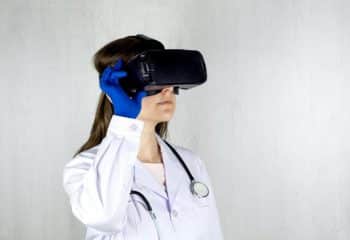Virtual health has been pushing the boundaries for over a decade now, and people are finally starting to accept this new way of healthcare. Technology has made virtual care possible with advanced machines and techniques that are more convenient and affordable for patients. As one of the most interesting and advanced techniques, virtual reality therapy is setting to change the way people see at-home healthcare.
Let’s delve into finding out what a virtual clinic is and what are some of its benefits.
What is a virtual clinic?
A virtual clinic is an online, two-way audiovisual interaction between patients and healthcare providers to assess reports of illnesses and injuries without having to wait for an in-person appointment at a hospital or clinic. This clinic is suitable for any patient determined by a consultant or a GP.
Virtual clinics can be used for initial consultations, ongoing home management and quality improvement planning, and even group sessions like rehabilitation clinics and therapies. The waiting time for a consult is dramatically reduced since patients have easy access to a clinician who can diagnose them and refer them to the right place. It not only reduces the wait time but also speeds up the recovery process.
The virtual clinic provides virtual interaction between patients and practitioners through telecommunication tools like smartphones, and one of the most popular tools nowadays, virtual reality. This provides engaging treatments, using a VR headset that optimizes the treatment in real-time, without having to leave your home. This benefits the patients, practitioners, and also healthcare organizations.
VR therapy
VR therapy refers to virtual reality immersion therapy, using virtual reality technology like a VR headset, for psychological or rehabilitation therapy. Patients navigate through digitally created environments and complete specifically designed tasks that are tailored to treat specific conditions. This isolates the user from their surroundings letting them immerse into an interactive virtual environment.
This therapy can be used to treat chronic conditions, anxiety, depression, and others, meaning it helps with physical and mental health. Patients are guided by professionals like occupational therapists, physical therapists, and speech-language pathologists. The best thing about this technology is that the patients are getting treated from the comfort of their homes.
The treatment is usually presented through graduated exposure, meaning the stimulus is presented in steps. This offers the patients to gradually experience the treatment. This therapy has also proven to be especially effective at regaining muscle control after a stroke, treating PTSD, and even improving social skills in those diagnosed with autism.
 Photo by Bermix Studio from Unsplash
Photo by Bermix Studio from Unsplash
Benefits of virtual clinics
The reason why more people are turning to virtual clinic treatments is that they offer plenty of benefits for modern-day patients.
Convenience and accessibility
Convenience is key in today’s healthcare world, being one of the leading advantages of the virtual clinic. This type of clinic offers simple, on-demand care, without having to waste time and money on in-person visits to the hospital or clinic.
This is especially beneficial for patients living in remote locations, homebound, or those who cannot afford to take time off work. The best part is that it’s easily accessible through smartphone apps and online platforms that connect patients with their providers, now easier than ever.
Cost-effective
Virtual clinics significantly reduce healthcare service costs, which not only applies to patients but also to their practitioners and insurance companies. It eliminates transportation expenses for regular checkups and even unnecessary non-urgent ER visits.
It offers remote analysis and monitoring services that notably reduce service costs. Instead of having to spend money on transport to and from the hospital or clinic, and additionally pay for medicine, this significantly helps in reducing patients' costs.
Increased patient engagement
People living busy lives today often neglect regular checkups, but with a virtual clinic, this can be quite beneficial since it’s easily approachable. This way patients might be more engaged to maintain appointments and care schedules.
This can also give healthcare providers a chance to increase engagement initiatives and help patients to curb tobacco use and obesity rates, encouraging them to make healthy lifestyle choices. Virtual care makes it easier for patients to report early warning signs, reach out with concerns, questions and make follow-up appointments to stay on track.

In closing
The implementation of virtual care can significantly improve the overall health and outcomes of patients using virtual clinics. Being convenient, approachable, and cost-effective makes it easier for patients to reach out. As times are changing, virtual clinics have a good chance of becoming a leading healthcare system sooner than expected. As more patients accept virtual care as standard practice, it can quickly become clinically and financially imperative, and not just a convenience.

Isreal olabanji a dental assistant and public health professionals and has years of experience in assisting the dentist with all sorts of dental issues.
We regularly post timely and trustworthy medical information and news on Fitness, Dental care, Recipes, Child health, obstetrics, and more.
The content is intended to augment, not replace, information provided by your clinician. It is not intended nor implied to be a substitute for professional medical advice. Reading this information does not create or replace a doctor-patient relationship or consultation. If required, please contact your doctor or other health care provider to assist you to interpret any of this information, or in applying the information to your individual needs.


